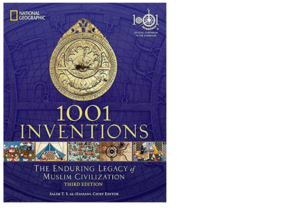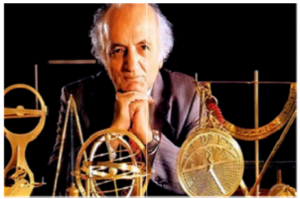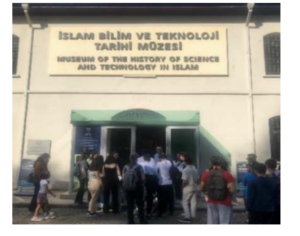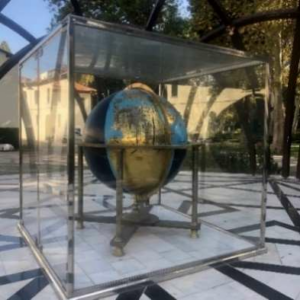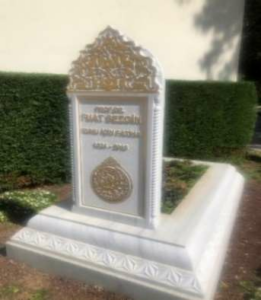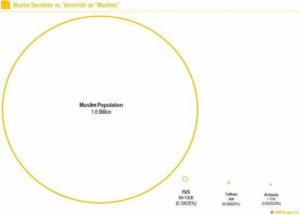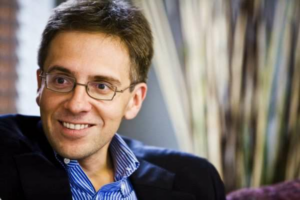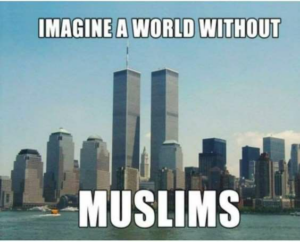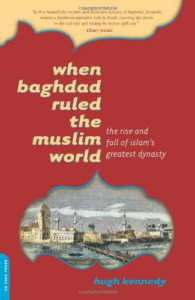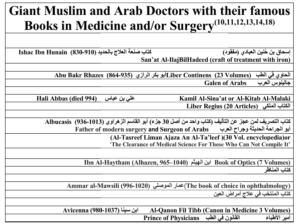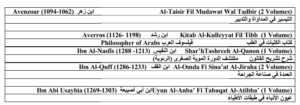
General Introduction
Comprehensive sources for Arabs and Muslim contributions to the Western civilization in science are generally scanty. However, a few excellent general books were written addressing this subject, alas incomplete. Examples include
- La Civilization des Arabes(the Civilization of the Arabs, written in French and translated into Arabic but without English translation) by Gustave Le Bon 1884.(1)
- Gustave le Bon (1841-1931) a French psychologist and anthropologist states in page 126 (as adapted from the Arabic translation): (Because it is the methodology of Allâh: “Islam, from among all religions, best suits the science discoveries and is the most ready to edify souls and force them to abide by justice, kindness and toleration.”)
- Influence of Islam on Medieval Europe, by W. Montgomery Watt (The New Edinburgh Islamic Surveys. 1972) (2)
- The Genius Of Arab Civilization: Source of Renaissance, by John S Badeau, Majid Fakhry, Oleg Grabar, et al. (New York University Press, 1975)(3)
Recently however, and within the last 25 years, an awareness of Western indebtedness to Arab/ Muslim Civilization in science was made publicly, mainly due to the three (3) contemporary sources illustrating the enduring legacy of Muslim Civilization in science.
- Salim T. S. Al-Hassani an Emeritus Professor of Mechanical Engineering at the University of Manchester. He is President of the Foundation of Science, Technology and Civilisation (FSTC), founder of www.MuslimHeritage.com ; and Chief Editor of the 1001 Inventions, touring exhibition, who built as a global education initiative which includes a book, award winning film and teacher’s pack.
Jameel Sadik “Jim” Al -Khalili CBE FRS ( ليمج يليلخلا قداص; born 1962) is professor of theoretical physics and chair in the public engagement in science at the University of Surrey. He is a regular broadcaster,commentator, and presenter of science programmes on BBC radio and television. Jim Al-Khalili presented Science and Islam (2009) a three-part BBC documentary about the history of science in medieval Islamic civilization, for which he travels through Syria, Iran, Tunisia, and Spain to tell the story of the great leap in scientific knowledge that took place in the Islamic World between 8th and 14th centuries (the so-called the Golden Age of Islamic science). The series is accompanied by the book ‘Science and Islam: A History’ written in 2017 by Hassan Ehsan Masood (born 1967) a British science writer, journalist and broadcaster (5)
The 3 Episodes
- “The Language of Science”
- “The Empire of Reason”
- “The Power of Doubt”
J Al-Khalili also wrote an excellent book (Pathfinders The Golden Age of Arabic Science – published by Penguin, 2012) (6)
3. Fuat Sezgin (1924 –2018) was renowned worldwide for reviving the works of forgotten Islamic era scientists. He was a Turkish orientalist, and a professor emeritus of the History of Natural Science at Johann Goethe University in F(Germany).Sezgin obtained a PhD from Istanbul University under the German Orientalist Hellmut Ritter in 1950. He moved to Germany in 1961 and got married to Ursula (German orientalist) and started working as a visiting professor at University of Frankfurt, and was appointed professor at the university in 1965. His research in Frankfurt focused on Islam’s Golden Age of Science. In 1982, Sezgin established the Institute of the History of the Arab Islamic Sciences (IHAIS) there (He was the founder and honorary director).
Sezgin also founded a unique museum within the IHAIS at Frankfurt (1983) and in Istanbul (2008), with more than 800 replicas of historical Arabic-Islamic scientific instruments, tools and maps (of the Golden Age of Islamic science). His best-known publication is the 17 volume work Geschichte des Arabischen Schrifttums (1967-2000) is the cornerstone and standard reference on the history of science and technology in the Islamic world. Sezgin had argued that Muslim seafarers had reached the Americas by 1420, citing as evidence the inscription on a map and the fact that the high longitudinal precision of early maps of the Americas would not have been attainable using Western navigational technology. When I (the author) visited Institute of the History of the Arab Islamic Sciences (IHAIS) at Gulhana Park (Istanbul) (7). i found a beautiful replica of the first Earth Globe as presented by Muslim scholars to the Abbasid Caliph Al- Ma’moon on his specific order; together with professor Fuat Sezgin burial site (died 2018, May Allah have mercy upon his soul).
In the wake of World Trade Centre explosion (Sept. 2001), and Paris Attack (Nov. 2015), President Trump comments ostracising Muslims as threat, and brandishing them as terrorists (!) was followed by unprecedented Islamophobia that swept the world, alienating Muslims and shunning any research in Islamic medical history.
However, Political Scientist and a University professor Ian Bremmer of New York has debunked that fallacy(8) he highlighted that radical ISIS only account for a negligible 0.00625% of 1.6 billion Muslim population. To hold a whole population responsible for the actions of a few is ignorant and racist. No one would ever expect Christians or White people to be held responsible for the acts of Timothy James McVeigh (Oklahoma bombing, killing 168 people – 1995), or Anti-Islamic Anders Breivik (Island of Utoya, Norway mass killing of 77 people – July 2011), or Brenton Tarrant (Mass shooting of 51 Muslims during Friday prayer in 2 mosques at Christchurch, New Zealand on 15th March 2019). Similarly, the rest of the 1.6 billion Muslims have nothing to do with these terrorist incidents (figure).
Furthermore, he wrote a provocative meme or article: (Imagine the World without Muslims, the post went viral in no time (figure)
Professor Ian Bremmer, highlighted many inventions made by Muslims, right from toothbrushes to hospitals
Without Muslims you wouldn’t have
Coffee
Cameras
Experimental Physics
Chess
Soap
Shampoo
Perfume/spirits
Irrigation
Crank-shaft, internal combustion
Engines, valves, pistons
Combination locks
Architectural innovation (pointed arch Gothic cathedrals adopted this technique as it made the building much stronger, rose buildings, round towers, etc.)
Surgical instruments
Anaesthesia
Windmills
Treatment of Cowpox
Fountain pens
Numbering system
Algebra/Trigonometry
Modern Cryptology
3 course meal (soup, meat/fish, fruit/nuts)
Crystal glasses
Carpets
Checks
Gardens used for beauty and meditation instead of for herbs and kitchen.
Universities
Optics
Music
Toothbrushes
Hospitals
Bathing
Quilting
Mariner’s Compass
Soft drinks
Pendulum
Braille
Cosmetics
Plastic surgery
Calligraphy
Manufacturing of paper and cloth
Indeed:
It was a Muslim who realized that light enters our eyes, unlike the Greeks who thought we EMITTED rays, and so Muslims invented camera based on this discovery.
It was a Muslim who first tried to FLY in 852 yet it is the Wright Brothers who took the credit
It was the Muslim: Jabir ibn Hayyan who is known as the founder of modern Chemistry. He transformed alchemy into chemistry. He invented distillation, purification, oxidation, evaporation and filtration. He also discovered sulfuric and nitric acid.
It was a Muslim: Al-Jazari who is known as the father of robotics.
It was a Muslim who was the architect for Henry V’s castle.
It was a Muslim: Ammar Al-Mawsilli who invented hollow needles to suck cataracts from eyes a technique still used today.
It was Muslims who actually discovered inoculation, not Jenner and Pasteur to treat cowpox. The West just brought it over from Turkey.
It was a Muslim who contributed to Mathematics, invented Algebra and Trignometry, which was imported over to Europe 300 years later to Fibonacci and the rest.
It was Muslims who discovered that the Earth was round 500 years before Galileo
The American historian ‘Olivia Goldhill’ in her article: (An Arab thinker invented economic theory 400 years before Adam Smith did) stated that Ibn Khaldun is the one who invented the science of Economics preceding Adam Smith by 400 years
In short, we would be nothing without Muslims.
A Critique
However, all above writers are in the field of engineering, physics, mechanics, politics, or in the history of science and physics. The medical discoveries and/or inventions mentioned by them (if any) are totally marginalised or rudimentary, because none of them are medical practitioners nor are they specialized in medical history; such medical history is purely based on biographies without the clear inter connected picture. While the remarkable contributions of Muslims to the evolution of science is now unblemished and well-established in History, there remains a major hiatus or lacuna (gap) in our knowledge and understanding of the history of Arab/Islamic pioneering achievements in Medicine.
Islamic medical history is a fertile field for research which remains unexplored fully. This original article therefore, is in-depth research written with the aim of closing and bridging this serious gap in our knowledge of Arab/Islamic Medical history. This illustrated and detailed account is a fruitful outcome of my life-time research in the history of Medicine and a cumulative wealth of information, travels, lectures to various bodies, societies, and museums and of many years of publishing of Medical historical articles (nine of my papers were already listed in ‘Wellcome Institute of History of Medicine’). It is probably, the first thorough and comprehensive review (though non-exhaustive) in the field of Medical Islamic history; this review puts things into perspective. It sets the scene clearly, acting as a springboard for future expansion in this fascinating field of research.
This account of Muslim achievements and pioneering works in Medicine reveals clearly, that many of their original Muslim discoveries/inventions were later attributed wittingly or unwittingly, to the Western physicians. In legal terms: these Muslim achievements were borrowed, covered-up and subsequently plagiarized and owned fraudulently, by the West (legally called: Theft of intellectual property).
Arab-Islamic influence on Western civilization in Medicine is a fascinating aspect of history of Medicine. In-depth research (over a 24 year-period: from 1986 to 2012) revealed the extent and magnitude of such colossal influence and its reflection on medical terminology and its ramifications in European vocabulary. This research was crowned by publication of 1500 pages. ‘Paradise Dictionary’ (in 2 volumes), the first dictionary in the world for English words of Arabic origin(9)
Phases of Evolution of Islamic Medical History.:(10,11,12,13,14)
There are myriad routes for Arabic influences on Europe: via the Crusaders, Andalusia, Sicily, Istanbul, commerce and trades, as well as colonial British presence in Middle East and Indian subcontinent. Cultural influence however, can be studied according to 3 phases of evolution of Arabic Medicine:
I. PHASE OF TRANSLATION (directly from Greek into Arabic, Or indirectly from Greek Syriac and then from Syriac into Arabic)
Abbasid Caliphs acquired Greek books from Romans and offered the equivalent weight of the translated book in gold to the translator (Naqqal). The famous Doctors of the time: Jurjis Ibn Jibrail, Yuhannah Ibn Masawayh and Hunayn Ibn Is’haq Al-Ibadi, at special request of successive Caliphs in Baghdad: Abu Ja’afar Al-Manzoor (754-775 AD), Haroun Al-Rashid (786-809 AD) and Al Mamoon (813-833 AD) respectively, undertook the arduous task of translating all Greek books into Arabic on unprecedented scale. Caliph Al Ma’moon ordered School of Translation to be attached to the Academy of Baghdad ‘BaytulHikma’ (House of Wisdom). He appointed Hunayn Ibn Is’haq Al Ibadi (808- 73 AD) as its head. Hunayn translated Galen’s books: ‘On Anatomical Procedures’ of which original Greek books IX to XV (inclusive) were totally lost.Arabic Translation was therefore, the preserving medium through which Arabic version preserved the Greek medical knowledge. Furthermore, the GOLD changed the fabric of society, so that the paper bookmakers (warraqeen) the writers (calligraphists or Khatt’ateen), and the translators (Naqqaleen) became a very rich echelon in the society, coming in status, after the princes (military leaders), ministers and scholars.
II. PHASE OF ARAB ORIGINAL CONTRIBUTIONSAND CREATIVE ACHIEVEMENTS
Abbasid Caliphate of the Islamic World with its capital in Baghdad became the centre of Gravity at the time and the centre of scientific radiation of the world. Thus, ‘Old World Order’ was created circa 700-1500 AD (for 8 centuries) with Arabic being the language of Islam becoming the lingua franca of the World. This Golden Era of Science reached its zenith in Abbasid Golden time (for 5 centuries: AD 754-1258, also known as the Golden Age of Islam and dominated Europe which was sinking in its Dark Medieval Ages.
For instance, in Anatomy, the assertion that Islam forbids dissection is untenable; Qur’an states: “And in yourselves, Can ye then not see? “Al Thariat, verse 21. Monkeys were dissected by Yuhannah Ibn Masawayh in 830; deers by Ibn Tufail in 1185; dead pregnant mothers and dead foeti were dissected by Rhazes and Albucasis. Dead human bodies were dissected by Avicenna (circa 1020) and by Ibn Al-Nafis (1288) Arabs left indelible imprints in many Anatomical terms. In Physiology, Systemic blood movement was described by Haly Abbas Al-Majusi (circa 994) 6.5 centuries before Harvey’s description in 1628. Capillaries discovery by Haly and Ibn Al-Quff (1233-1286) 4 centuries prior to M. Malpighi’s discovery in 1661. Pulmonary circulation was described by Ibn Al-Nafis (1211-1288) 3 centuries before Michael Servetus report in 1553.
Muslims also pioneered many advances in chemistry, pharmacology, microbiology, and in Food, Nutrition, and Health leaving their legacy behind.
Muslims mastered Medicine and Surgery and manufactured many instruments and invented ‘anaesthetic sponge’. Command of anatomy, anaesthesia, antisepsis and instruments made abdominal surgery and Caesarean section feasible events. Furthermore, the Black gown of graduation from the Medical colleges was derived from black Abbasid Aba’ as symbol of nobility.
Baghdad being the Capital of Islamic World (Old World Order) had become the Centre of international attraction for all scholars from different corners of the world irrespective of their nationality, ethnic background, creed, or religion; they all flourish in Baghdad (the Centre of the World at that time). Progress of Medical Sciences and Excellence of Clinical Practice were not related to Greatness of Muslim Pioneers (Rhazes, Avicenna, Alhazen and others) as much as they are related to congenial environment in Baghdad, the capital of Islamic World. Baghdad was simply the magnet and the incubator for ‘seeds and soil’ for all Medical and Scientific progress.
Professor Hugh Kennedy in 2006 wrote an excellent book to document Baghdad’s leadership of the World
This can explain the term Baghdadah ةددــغبلاas synonym for grandiosity, beauty, and excellence; it also explains the Worldwide Spread of ‘Baghdad’ name among many cities in the World:
There are about 19 places named Bagdad (without H)
or Baghdad in theWorld:
Eleven (11) cities named ‘Bagdad’ in USA alone:
Bagdad, Arizona USA
Bagdad, Florida USA
Bagdad, Kentucky USA
Bagdad, Louisiana USA
Bagdad, Pennsylvania USA, 2 cities
Bagdad, California USA,2 cities
Bagdad, New York, USA
Bagdad, Virginia, USA
Bagdad, Washington, USA
There is also, one in each of: Uzbekistan, Somalia
Romania, Mexico, French Guiana, Tasmania (Australia), Afghanistan, and one Baghdad in Iraq.
Because of the establishment of another late Fatimid Caliphate in Egypt and because of the excessive travel of Egyptians all-over the World, and migration of many Iraqi scholars to Egypt (e.g. Ibn Al-Haytham Ammar Al-Mawsili), Cairo became a popular name too. There are 25 places named Cairo in the world: 19 places named Cairo in America; 2 places named Cairo in Colombia; one place named Cairo in Peru; one place in Italy; one place in Costa Rica, and one Cairo in Egypt.
Similarly, the Umayyad Caliphate capital Damascus together with excessive travels of Syrians throughout the world, made the name Damascus popular too. There are15 places in the World named Damascus, 13 of which are in America, one in South Africa, and one Damascus in Syria. (16)
III. PHASE OF REVERSED TRANSLATION (from Arabic into Latin, followed by eradication of all Arabic texts, and then removing all Arabic terms by the Humanists. Then Renaissance emerged as European phase in the New World Order).
Most Arabic texts were translated into Latin by famous translators such as:
Constantinus Africanus (1020-87) at Monte Cassino,
Gerard of Cremona (1114-87) at Toledo,
Moses Farachi. The latter was a Sicilian Jew who at the order of King Charles of Anjou in 1279, undertook the arduous assignment of translating Rhazes’ “Liber Continens” (23 volumes) during his lifetime.
In 1085, Toledo fell to Spanish and, Toledo School of Translators and for 4 centuries running, continued to bring vast stores of knowledge to Europe by rendering great academic and philosophical works of Arabic into Latin. Religious intolerance took place after the so called Spanish Reconquest, which resulted in Inquisition Tribunals (in 1492), with pre-planned programmed deliberate eradication of Islamic/Arabic culture starting with burning of thousands of Arabic books, and ending with expulsions of all Muslims even after their conversion to Catholicism (Moriscos) as well as many Conversos and Marranos (Jews publicly recanted Jewish faith and adopted Catholicism under the pressure of Spanish Inquisition pressure).
Against this tyranny and religious intolerance, Conversos and Moriscos exploded in the 1520 1521 Revolt of the Comuneros, a popular uprising in Castile against the rule of King Charles V.
This was followed by the Humanists movement aiming at purifying Medicine and Science by casting out all Arabic terms. In fact, the progress in Western civilisation had begun in 11th/12thcenturies, and was the result of the transfer of Arabic civilisation to Europe.
The 16th century Renaissance (meaning Re-birth of Arabic texts, but fraudulently owned by the Europeans) was rather the construction of an exclusive Christian European identity within the world of literature and science. For instance, during this Renaissance period, most medical knowledge was available only in Arabic texts. Andreas Vesalius (1514-1564), the so-called father of modernanatomy dissected human cadavers. Fluent in Arabic, he wrote “A Commentary on the fourth Fen of Avicenna”, followed by his baccalaureate thesis, “Paraphraseon the Ninth Book of Rhazes in 1537 long before his masterpiece, ‘De Humani Corporis Fabrica Libri Septem’ (Seven Books on Human Body Structure) in 1543.
Latin humanists created a movement imitating the Arab tradition in its key values, but distinguishing itself by classical Latin as its lingua franca and the classical authors as its founding fathers. After a period in which classical culture was vigorously celebrated and Arab influences were deliberately removed from the scientific canon, the image of a Greek source of European culture had settled itself firmly in the European mind. Scholars hardly dared cite an Arab in support of their revolutionary developments.(17)
By losing the original Arabic texts, many translated books in Latin were then plagiarised and the authorship were owned fraudulently, by Western scholars. However, many Arabic words escape detection and remained within the infrastructure of medical terminology; ‘Paradise Dictionary’ by the author documented that legacy. (9)
This phase in Europe, starts with Columbus’ supposed discovery of America in 1492 AD, and is ushered in what is called (New World Order) and extends from 1492 AD till now; the Western world (Europe and America) considered English, as the lingua franca of the New World order, followed by French, and Spanish, according to which they classified World nations into: Anglophone Francophone, and Hispanophone or Hispani countries Currently, however, and after prolonged pressure from Arab countries (especially Saudi Arabia), the six official languages of the United Nations (UN) have now become in this order: Arabic (Arabophone), Chinese (Sinophone), English, French, Russian and Spanish
References
- Gustave Le Bon. La Civilization des Arabes(the
Civilization of the Arabs, written in French and
translated into Arabic, but without English
translation). 1884. - W. Montgomery Watt. Influence of Islam on
Medieval Europe. The New Edinburgh Islamic
Surveys. 1972. - John S Badeau, Majid Fakhry, Oleg Grabar, et al
The Genius Of Arab Civilization: Source Of
Renaissance. New York University Press, 1975 - Salim T. S. Al-Hassani (Chief Editor) (Now
undertaken by National Geography). 1001
Inventions. 3rd Edition. 2012. - H E Masood. ‘Science and Islam: A History’. BBC
series, 2017. - J Al-Khalili. Pathfinders The Golden Age of Arabic
Science. Penguin, 2012. - Personal visit.Institute of the History of the Arab
Islamic Sciences (IHAIS) at Gulhana Park (Istanbul). - Professor Ian Bremmer. meme entitled: (Imagine the
World without Muslims). 2019. - Al-Fallouji M A R. ‘Paradise Dictionary’ of English
words of Arabic Etymology (1500 pages in 2
volumes). 2012. - Al-Fallouji M A R: History of Surgery of the
Abdominal Cavity: Arabic Contributions. (The First
Large Bowel Anastomosis in the Literature).
International Surgery September 1993; 78:3:236-8 - Al-Fallouji M A R: History of Arab Surgery. Part I:
General Considerations. - Emirates Medical Journal August 1992; 10:174-7
- Al-Fallouji M A R: History of Arab Surgery. Part
II: Arab-Islamic influence on Europe. Emirates
Medical Journal December 1992;10:250-4 - Al-Fallouji M A R: History of Arab Surgery. Part
III: Basic Applied Sciences in Surgery. Emirates
Medical Journal August 1993; 11:132-6 - Al-Fallouji M A R: History of Arab Surgery. Parts
IV and V: Clinical Methods and Operative
Innovations. Emirates Medical Journal August 1998;
16:129-34 - Kennedy H. When Baghdad Ruled the Muslim
World: The Rise and Fall of Islam’s Greatest
Dynasty. March 14, 2006 - How many places named in the world. Website:
geotarget.com. - Abdul Haq Compier, How Europe Came to Forget its
Arabic Heritage. Al Hakam website. Holland (18th
January 2019- Updated 2020). - Wikipedia under bibliographic names.

